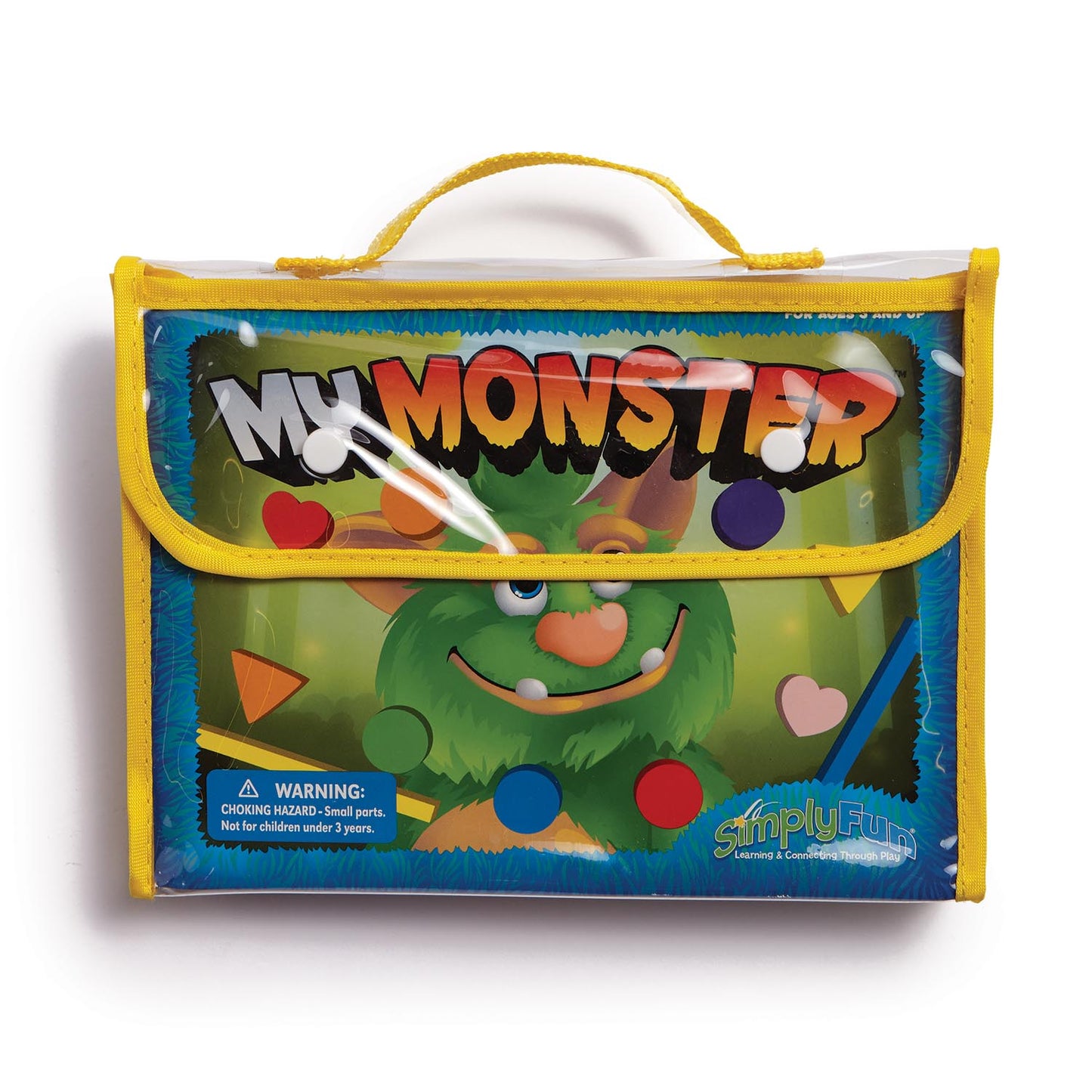
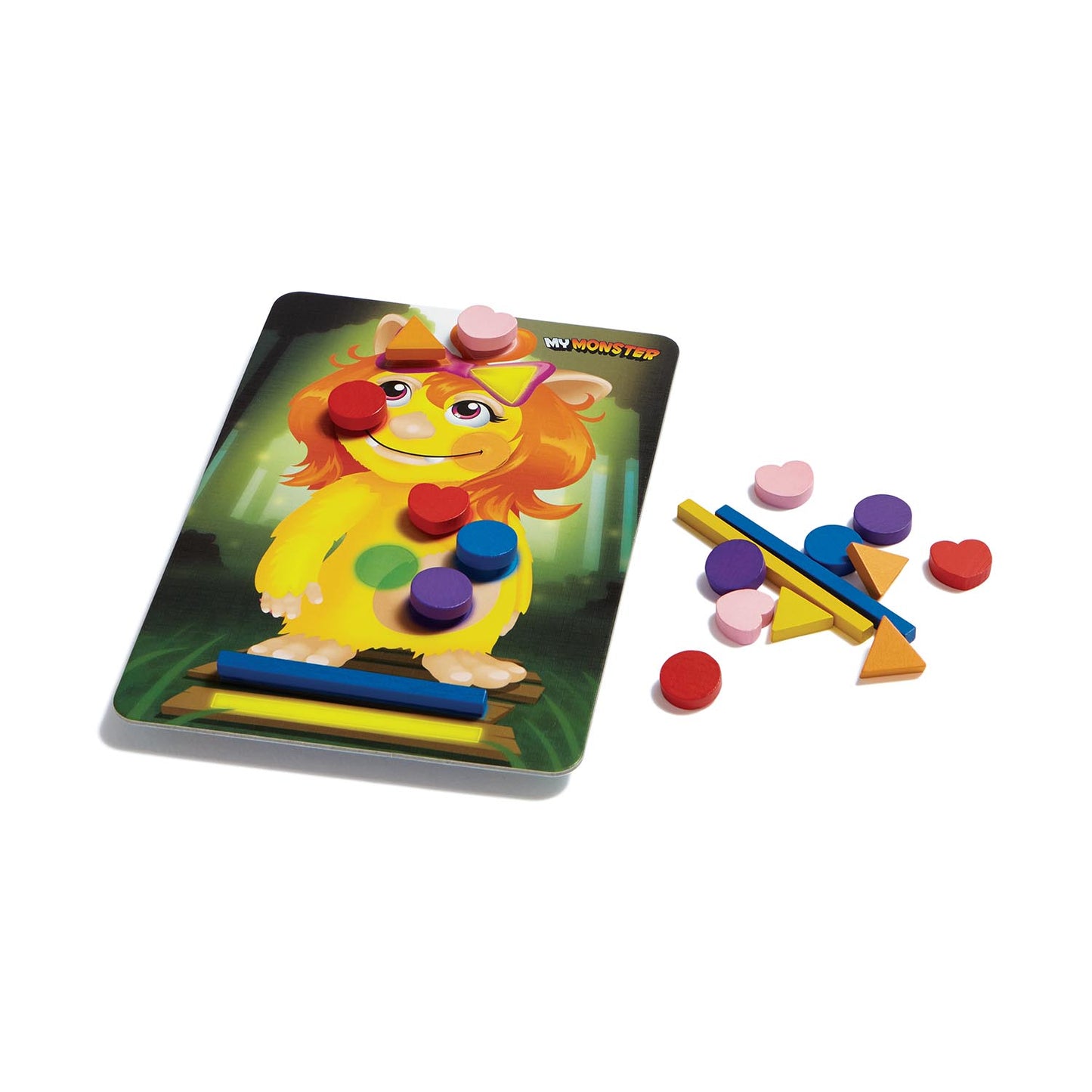

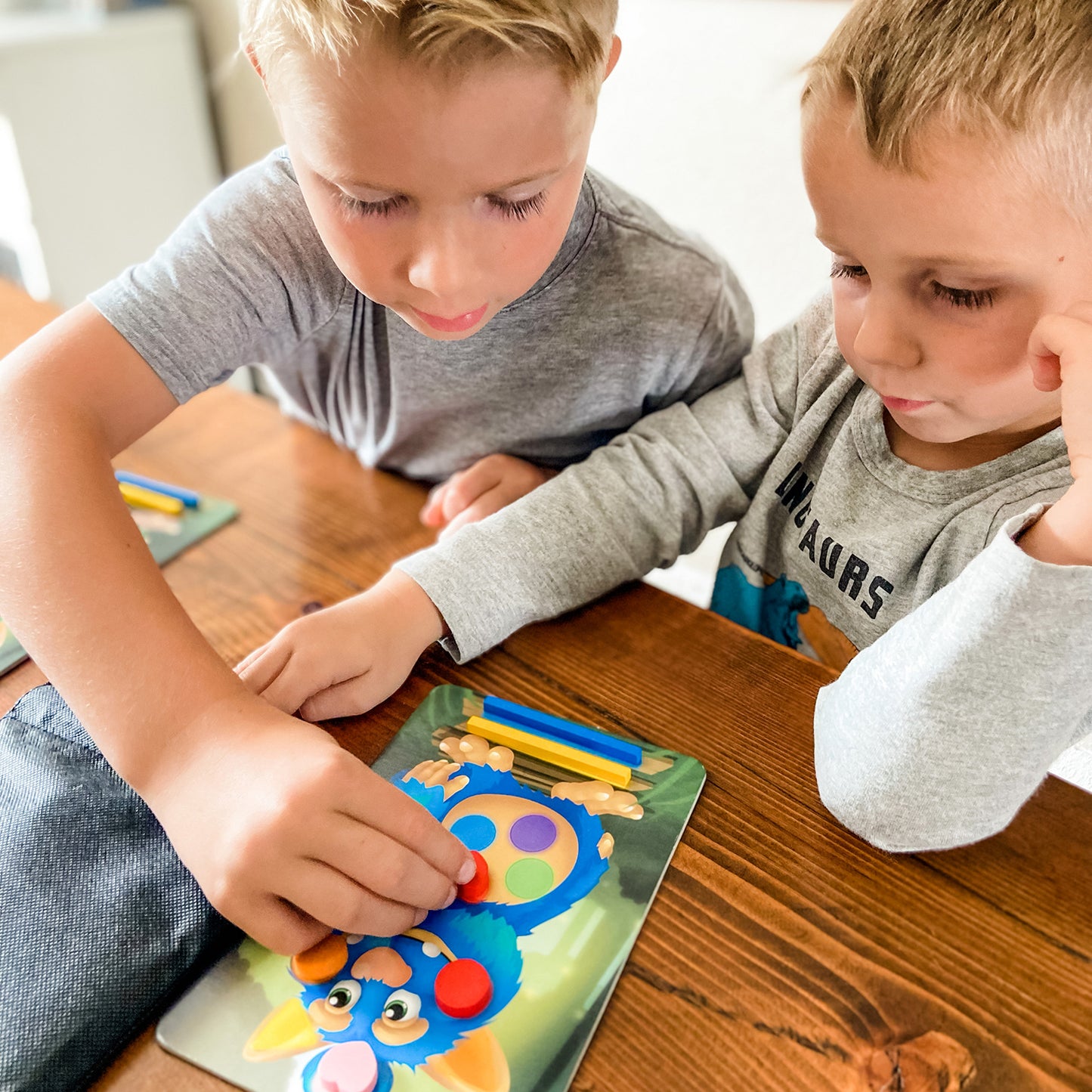
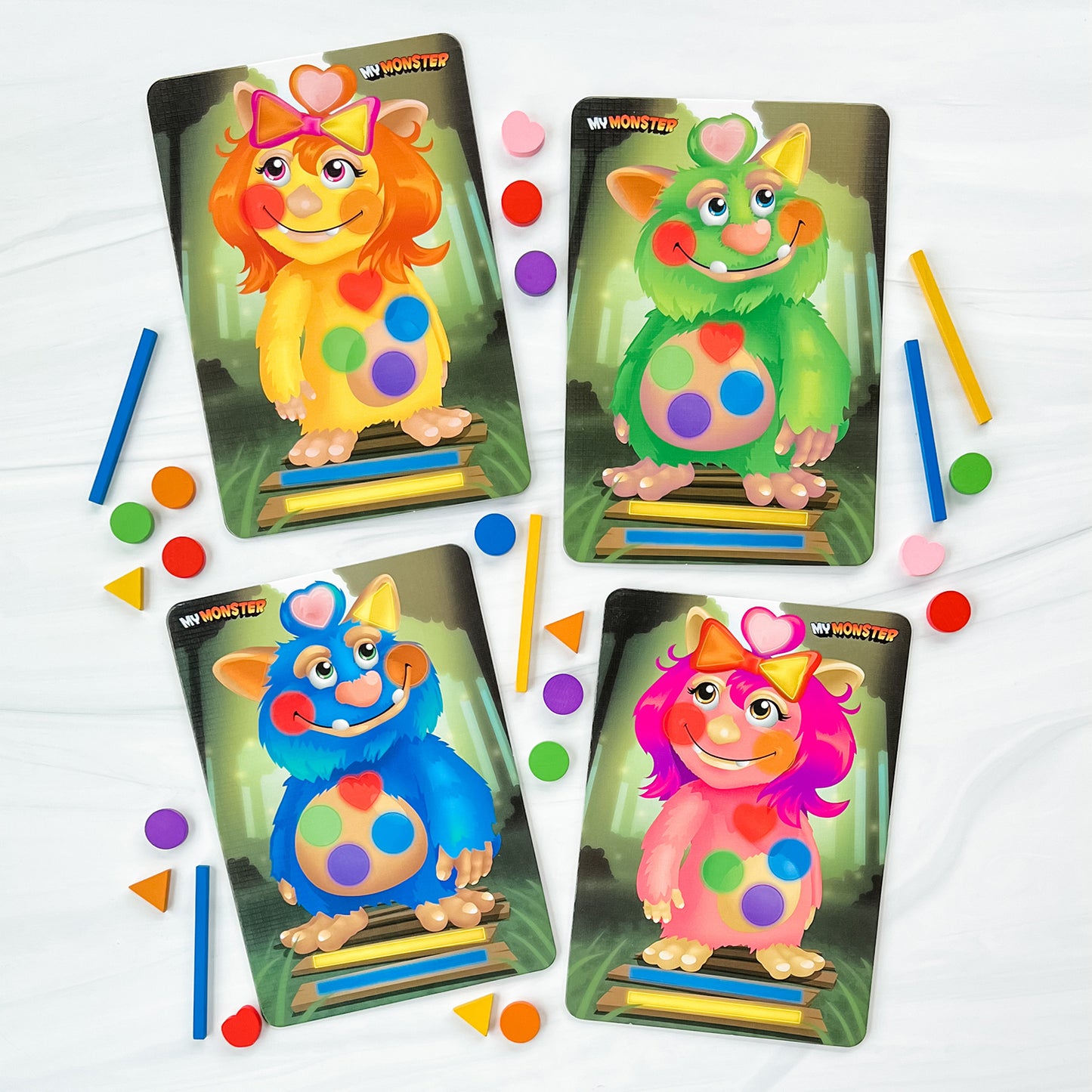
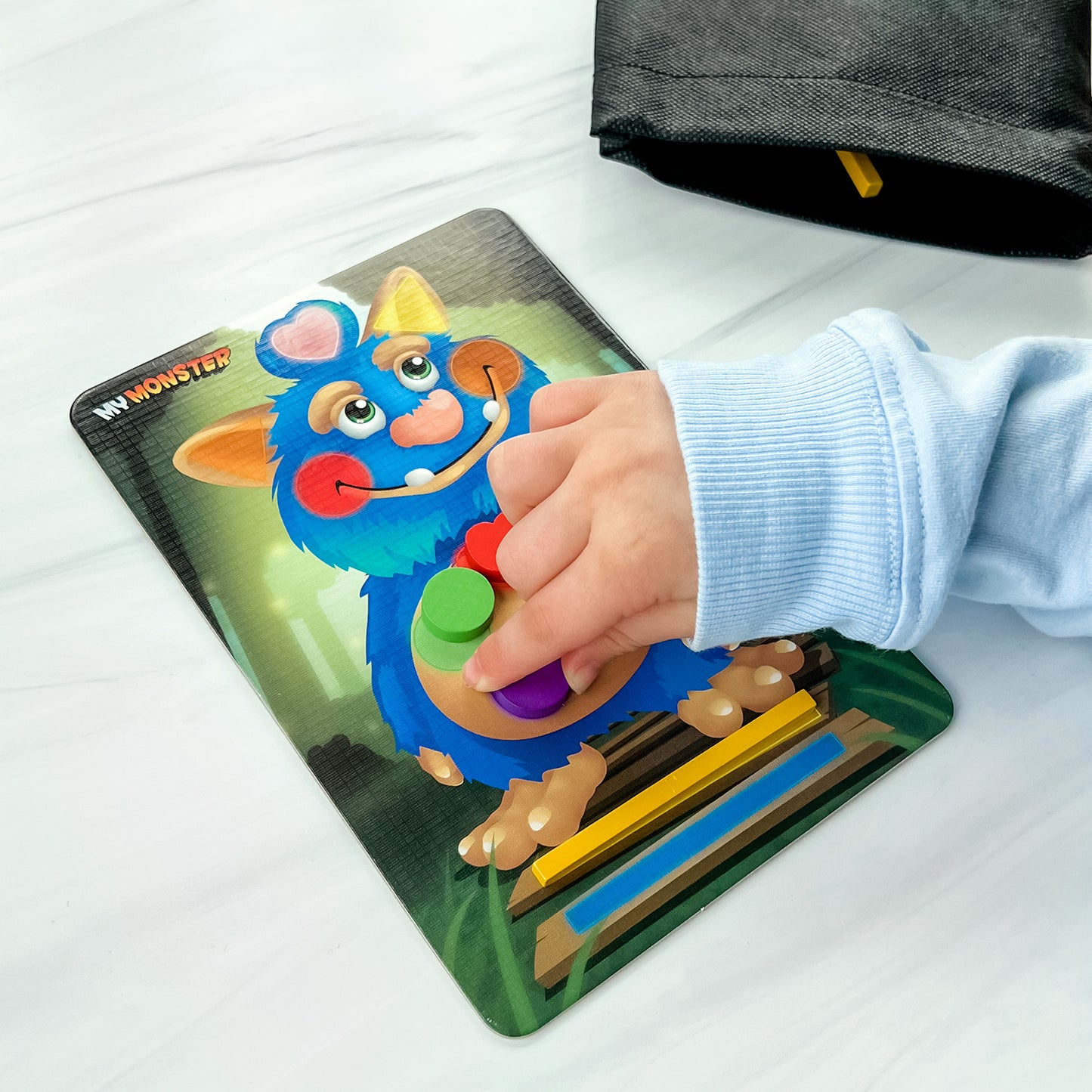
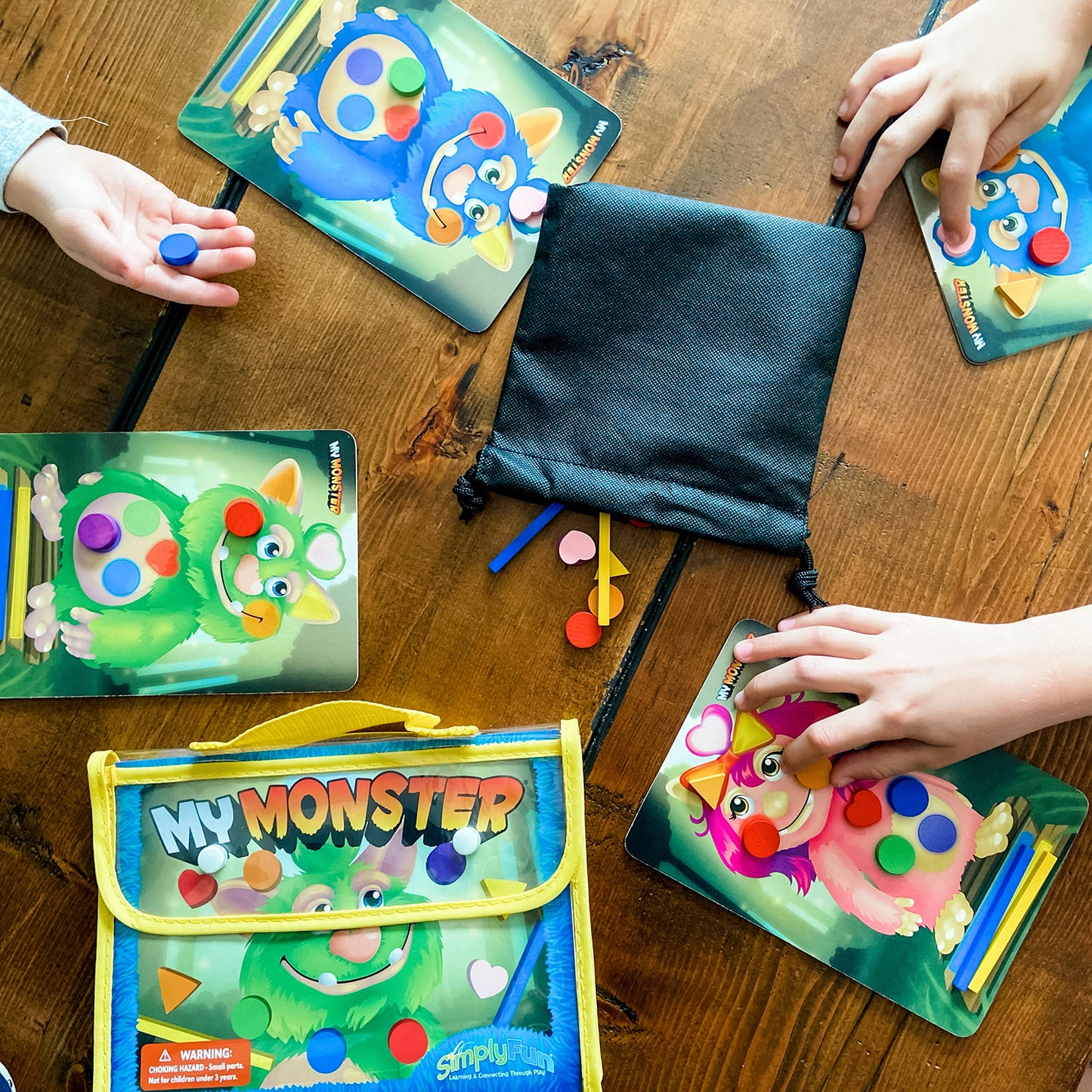

Collapsible content
A game where you use your sense of touch to determine which of the hiding shapes will complete your friendly monster.
You can play My Monster with 2-4 players, ages 5 and up.
My Monster is good for developing Tactile Skills as players reach into the cloth bag, feel the shapes and select a piece without looking.
My Monster also helps with Probability as players consider the likelihood that the shape they have selected matches the color on their Monster Board.
Give each player a monster board and let them choose which side to play.
Place all the Monster Pieces in the Cloth Bag.
Players take turns selecting a Monster Piece from the bag and matching it to the correct shape and color space on their Monster Board. The first player to complete their monster by correctly matching all the empty spaces on their Monster Board with the correct Monster Pieces wins the game!
The first player takes the bag and pulls out a Monster Piece. Players must not peek inside the bag while selecting a Monster Piece, although they may spend some time feeling the shapes of the pieces in the bag before selecting one.
If the selected Monster Piece matches an empty space with the same shape and color on their Monster Board, they may fill that space with the Monster Piece and end their turn.
If the space is already occupied by another matching Monster Piece, or if is not a matching color, then they must put the selected piece back into the bag and end their turn.
After a player’s turn, they pass the bag clockwise to the next player and gameplay continues.
The game ends when one player matches all the shape and color spaces on their Monster Board with the correct Monster Pieces.
Match colors and shapes and complete your friendly monster with My Monster!


Head Start*
English Language Arts
- Listening & Speaking
- Shows progress in understanding and following simple and multiple-step directions.
- For non-English-speaking children, progresses in listening to and understanding English.
- Develops increasing abilities to understand and use language to communicate information, experiences, ideas, feelings, opinions, needs, questions and for other varied purposes.
- Reading - Foundation Skills
- Develops growing understanding of the different functions of forms of print such as signs, letters, newspapers, lists, messages, and menus.
Math:
- Numeracy & Operations
- Begins to make use of one-to-one correspondence in counting objects and matching groups of objects.
- Develops increased abilities to combine, separate and name “how many” concrete objects.
- Geometry & Spatial Sense
- Begins to recognize, describe, compare and name common shapes, their parts and attributes.
- Begins to be able to determine whether or not two shapes are the same size and shape.
- Shows growth in matching, sorting, putting in a series and regrouping objects according to one or two attributes such as color, shape or size.
- Patterns & Measurement
- Shows increasing abilities to match, sort, put in a series, and regroup objects according to one or two attributes such as shape or size.
- Begins to make comparisons between several objects based on a single attribute.
Science
- Scientific Skills & Methods
- Develops increased ability to observe and discuss common properties, differences and comparisons among objects and materials.
- Reasoning & Problem-Solving
- Develops increasing abilities to classify, compare and contrast objects, events and experiences.
Core Standard*: Math
Math
- Counting & Cardinality
- Count to tell the number of objects. Grade Level K
- Geometry
- Identify and describe shapes. Grade Level K
- Analyze, compare, create and compose shapes. Grade Level K


Explore
What Does Child Do To Use Skill In The Game?
Players explore when they put their hands in the bag to get a shape. They can feel the shapes and guess the shape they will pull out.
How Parents Can Assist Learning
Parents should encourage children to feel for the shape they want. Ask them to describe what they feel, and predict what shape they have in their hand before they pull it out.
Learning Implications and Educator Support
My Monster involves mental imaging, creating a mental image based on senses other than the eyes. Educators should encourage children to feel for the shape they want. Ask them to describe what they feel, and predict what shape they have in their hand before they pull it out.
Determine
What Does Child Do To Use Skill In The Game?
Players determine which shape to pull out of bag, and whether it is what they expected.
How Parents Can Assist Learning
Parents can ask children to describe the shape the expected and the one they chose.
Learning Implications and Educator Support
My Monster involves mental imaging, creating a mental image based on senses other than the eyes. Educators can ask children to describe the shape the expected and the one they chose. Children match both shape and color.
Compare
What Does Child Do To Use Skill In The Game?
When the shape and color matches Players can see they are correct. Players can also see what shapes are left to fill and figure out what shapes they still need to find.
How Parents Can Assist Learning
My Monster requires matching, so parents are encouraged to name each shape as the child looks at it. "You found a green circle!" If children are learning the names of colors and/or shapes, they can be asked to name the color or shape. "What did you find?" Encourage children to count each of the colors and shapes.
Learning Implications and Educator Support
My Monster requires shape and color matching, so educators can name each shape as the child looks at it. "You found a green circle!" If children are learning the names of colors and/or shapes, they can be asked to name the color or shape. "What did you find?" Encourage children to count each of the colors and shapes.
Predict
What Does Child Do To Use Skill In The Game?
All players must predict whether a specific jewel will be seen or not.
How Parents Can Assist Learning
Parents should encourage children to try to figure out the trajectory of the light beam created by the orientation of the mirrors. Then compare where they think the beam will end with what they remember is on that card. Remind children to use the light lines on the game board to help determine the trajectory of the light beam.
Learning Implications and Educator Support
Educators should encourage children to try to figure out the trajectory of the light beam created by the orientation of the mirrors. Then compare where they think the beam will end with what they remember is on that card. Remind children to use the light lines on the game board to help determine the trajectory of the light beam.
Plan
What Does Child Do To Use Skill In The Game?
How Parents Can Assist Learning
Learning Implications and Educator Support
Educators can extend the learning by using the math concepts "more," "less," and the "same." Ask whether there are more hearts or circles? Compare the number of rectangles and triangles, etc. This will help children compare amounts.
Experiment
What Does Child Do To Use Skill In The Game?
Players can feel the shapes and predict the shape they will pull out.
How Parents Can Assist Learning
Children may not try to feel and predict without the parent making a suggestion. In other words, children may just reach into the bag and pull out the first object they touch. Guide children to move slowly and think about what shape they are feeling. You can use a phrase like "Wait. Think. Feel." This will help with impulsivity and planning. Also, using such cues can give children a model for future play.
Learning Implications and Educator Support
Children may not try to feel and predict without the educator making a suggestion. In other words, children may just reach into the bag and pull out the first object they touch. Guide children to move slowly and think about what shape they are feeling. You can use a phrase like "Wait. Think. Feel." This will help with impulsivity and planning. Also, using such cues can give children a model for future play.
Practice
What Does Child Do To Use Skill In The Game?
Players have to know when they have completed their Monster.
How Parents Can Assist Learning
Encourage children to examine their Monster and see what they still need. Suggest they try to find what they need by feeling with their fingers in the bag.
Learning Implications and Educator Support
Children plan by observing what is missing from their Monster and trying to discover a matching piece. Encourage children to examine their Monster carefully on each turn to see what they still need. Suggest they try to find what they need by feeling with their fingers in the bag.
Demonstrate
What Does Child Do To Use Skill In The Game?
Players match all the shapes and colors correctly.
How Parents Can Assist Learning
Ask children to declare which pieces they need to complete their card.
Learning Implications and Educator Support
Ask children to declare which pieces they need to complete their card.
Imagine
What Does Child Do To Use Skill In The Game?
Players may review if encouraged. See How Parents Can Assist Learning.
How Parents Can Assist Learning
After the child's board is completed, go through each piece that they found so they can name them. Time for high five!
Learning Implications and Educator Support
After the child's board is completed, go through each piece that they found so they can name them. Time for high five!
*Data compiled from CCSSI ELA Standards, WA Science Standards, and Washington Social Studies Standards


Cognitive
Suggestions for How to Modify Play Experience
Children can find and place the shapes and name the color. The adult can ask, "What else do you need? The child then counts what is missing and says, 'One triangle and two circles.'" This encourages children to visually scan and count.
Communication
Suggestions for How to Modify Play Experience
Modify the game so that one player takes two shapes out of the bag and holds them hidden in their fists. The next player then points to one of the hands and guesses what shape is in it. The first player opens that hand and say, "Yes! It's a circle." or "No, it's a triangle." If the child guesses right, they get the shape. If the guess is wrong, the other player gets the shape. This modification is a communication, sensorimotor and social adaptation.
Sensorimotor
Suggestions for How to Modify Play Experience
Children with fine motor problems can practice in-hand manipulation. Have them draw and hold several shapes in one hand. They then look at their shapes, select one and move it down to their fingers without using the other hand. This requires the child to hold some in the palm and manipulate the one they want down to their fingers to place it.
Modify the game so that one player takes two shapes out of the bag and holds them hidden in their fists. The next player then points to one of the hands and guesses what shape is in it. The first player opens that hand and say, "Yes! It's a circle." or "No, it's a triangle." If the child guesses right, they get the shape. If the guess is wrong, the other player gets the shape. This modification is a communication, sensorimotor and social adaptation.
Social Emotional/Behavioral
Suggestions for How to Modify Play Experience
Modify the game so that one player takes two shapes out of the bag and holds them hidden in their fists. The next player then points to one of the hands and guesses what shape is in it. The first player opens that hand and say, "Yes! It's a circle." or "No, it's a triangle." If the child guesses right, they get the shape. If the guess is wrong, the other player gets the shape. This modification is a communication, sensorimotor and social adaptation.
Vision
Suggestions for How to Modify Play Experience
Some children with visual impairment will not be able to play this game because of need to match color and shape of relatively small objects. If appropriate, allow the child to use a magnifying glass.
Hearing
Suggestions for How to Modify Play Experience
No modifications required.
*Data compiled from CCSSI ELA Standards, WA Science Standards, and Washington Social Studies Standards


Autism Strengths & Interests
Short Summary of Strengths & Interests
- Likes physical, tactile activities.
- Prefer activities that are concrete and literal.
- Likes to make color and shape matches.
Is good at matching visual items
Is This Game Appropriate? Yes
Description
My Monster is a simple game requiring only matching of color and shape. Thus, it is a good game for children who enjoy matching or are curious to learn how an object and image are similar.
Has a good memory for sensory details, including visual, touch, taste and smell
Is This Game Appropriate? Yes
Description
Children who enjoy touching objects and manipulating them may like My Monster, as they may be able to identify needed shapes through tactile exploration in the game bag. The more they play the game, the quicker they will be able to identify shapes as they remember how the different shapes feel. Players also learn sharing and awareness of other's needs when they choose a piece they don't need and give it to another player who needs it.
Has a good memory for words, phrases and dialouge
This game is not appropriate
Has a good memory for pictures, numbers and patterns
This game is not appropriate
Likes to put things in order or a sequence
This game is not appropriate
Learns through visualizing or "replaying" actions in their mind
This game is not appropriate
Likes activities with rules, such as math and phonics
This game is not appropriate
Is very concrete and literal
Is This Game Appropriate? Yes
Description
Some children prefer activities that are very straightforward and direct. My Monster fits well for this preference as children are trying to match an object (ex: red heart) with an image of the same shape and color on their Monster Board.
Learns in small "chunks" (for example, phone numbers are 3 chunks of number xxx-xxx-xxxx that are combined together)
This game is not appropriate
Is good at nonverbal reasoning and logic
This game is not appropriate
Likes spatial problem solving
This game is not appropriate
Can read well with good vocabulary, though may not fully comprehend content
This game is not appropriate
Likes to use and has good fine motor skill
Is This Game Appropriate? Yes
Description
Children with autism who enjoy playing with small objects like building blocks may enjoy using that skill in My Monster. If they find a matching object on their turn, children need to orient and place the object on the corresponding spot on their Monster Board.
Likes established routines or set ways of doing things
This game is not appropriate
Likes manipulating, constructing or building things
Is This Game Appropriate? Yes
Description
Children who like manipulative activities like puzzles and shape sorters will enjoy using their skills playing My Monster.
Likes to use and has good musical abilities
This game is not appropriate
Likes to use and has good drawing skills
This game is not appropriate
Autism Special Considerations
Appears to ignore other's communication and/or has difficulty giving eye contact to a communication partner
Is This Game Appropriate for Child with Characteristic? Yes
Can Child with Characteristic Play Game w/o Modification? Yes
Strategies for Developing Compensatory Skills:
Sit at an angle to the child, so direct eye contact is not needed.
Look at the game instead of each other.
Use unusual or exaggerated inflection to begin a communication about the game. This attracts the child's attention
Has difficulty understanding complex verbal directions
Is This Game Appropriate for Child with Characteristic? Yes
Can Child with Characteristic Play Game w/o Modification? Yes
Strategies for Developing Compensatory Skills:
Combine short verbal instructions with visual and physical examples of each step.
Check for comprehension by asking the child to show you what to do next. "What do you do now?"
Uses vocabulary inaccurately or demonstrates echolalia (repeating another's speech)
Is This Game Appropriate for Child with Characteristic? Yes
Can Child with Characteristic Play Game w/o Modification? Yes
Strategies for Developing Compensatory Skills:
Provide the correct word if children mislabel a piece.
Respond to immediate echolalia (repeating what was just said) by rephrasing the child's response into a correct format, so the child can hear and repeat that phrase. For example, assume you are playing with a child named Andy and you say, "Your turn," and Andy repeats, "Your turn." You can say, "It's Andy's turn. You say, my turn." This allows the child to hear and repeat the correct response. Eventually, the child will pick up the pattern of response.
Delayed echolalia (repetition of previously heard comments) may have a hidden meaning or association. Look for connection in the phrase used to the current situation. For example, the child says, "After these messages we'll be right back!" Think what the repeated phrase is associated with for the child. Try to interpret what is meant and rephrase it for the child. For example, you might respond by saying, "It sounds like you want a break for a few minutes. Is that what you mean? You can tell me, 'I need a break.'"
Gets stuck repeating a verbal topic or physical actions and/or has difficulty attending to others' actions or topic.
Is This Game Appropriate for Child with Characteristic? Yes
Can Child with Characteristic Play Game w/o Modification? Yes
Strategies for Developing Compensatory Skills:
Incorporate a preferred topic into the game to increase motivation. For example, if the child is fixated on a particular character, like a favorite super hero, ask what the character would do next?
Practice phrases for commenting on others' play actions. For example, you say to Joe (who is playing with you), "Joe matched the color. What color did Joe pull out?" Remind children about listening and watching others' before making their own comment or action.
Practice turn-taking in conversation. Use a cue, such as a touch on the shoulder, if needed.
Use the child's finger to point to what needs attention. They will attend to their finger first, and then the adult can point out the object they are pointing at, for example the different colors on the monster card.
Extend the child's action to make a correct response. For example, if the child says, "Red," you could say, "Yes that is red. Where does red go?"
Reinforce attention and actions by commenting on what was done correctly. For example, "You matched all your colors!"
Has difficulty producing speech/communication
Is This Game Appropriate for Child with Characteristic? Yes
Can Child with Characteristic Play Game w/o Modification? Yes
Strategies for Developing Compensatory Skills:
My Monster can be played without talking, but communication should be encouraged. Labeling shapes and colors is an important part of the learning.
Extend the child's sounds into words or words into phrases to provide a model. For example, if the child says, "Green," you could say, "Green heart."
Provide at least 10 seconds wait time for the child to process or produce responses. It may take longer to formulate a thought or response for children with special needs.
Has difficulty sequencing multi-step actions and/or doing complex abstract tasks
Is This Game Appropriate for Child with Characteristic? Yes
Can Child with Characteristic Play Game w/o Modification? Yes
Strategies for Developing Compensatory Skills:
The directions are not complex for this game.
Demonstrates difficulty initiating and maintaining social interactions
Is This Game Appropriate for Child with Characteristic? Yes
Can Child with Characteristic Play Game w/o Modification? Yes
Strategies for Developing Compensatory Skills:
Role play social situations and reinforce appropriate words and actions. For example, role play commenting on another player's turn. For instance, "You only need one more color."
Use video feedback of positive social behaviors. Video of actual play enables children to see what they or others did. Appropriate actions and interactions can then be discussed.
Acts out or demonstrates avoidance behaviors when frustrated, overwhelmed, or needs more sensory input.
Is This Game Appropriate for Child with Characteristic? Yes
Can Child with Characteristic Play Game w/o Modification? No
Strategies for Developing Compensatory Skills:
Reduce extraneous noise or allow the child to wear head phones or ear plugs if loud sounds cause anxiety.
A weighted vest worn during the game may provide additional pressure input and thus reduce fidgeting due to sensory needs. Pressure can be calming when used for no more than 20 minutes at a time.
Practice a phrase to ask for help and role play situations in the game where it is needed.
Provide techniques for self-calming, such as holding a special toy.
Allow time for movement. For example, a child who needs to move frequently can be given an opportunity to 'celebrate' their turn by running around the table or jumping up and down 10 times.
Has short attention span for non-preferred activities
Is This Game Appropriate for Child with Characteristic? Yes
Can Child with Characteristic Play Game w/o Modification? Yes
Strategies for Developing Compensatory Skills:
This is a quick game, so the child should be able to maintain attention as long as completion of the task is motivating. If it is not, the adult needs to show excitement and encourage each turn.."
Needs sameness or consistent routines and/or has difficulty with transitions from one activity to another
Is This Game Appropriate for Child with Characteristic? Yes
Can Child with Characteristic Play Game w/o Modification? No
Strategies for Developing Compensatory Skills:
Play games at the same time every day, so the child anticipates the game routine.
Change the location of the game, so the child may play in different rooms, at the table, or on the floor. This will build tolerance for variation.
Prepare the child ahead time for the introduction of a new game. Talk about aspects that will be motivating for the child, and let them explore the parts of the game before setting out the whole game.
Provide a structure for placement of game pieces that can be the same each time the game is played. For example, have a specific location for where the board goes, the pieces, etc.Provide choices for how the child can be involved in set up or clean up. For example, you might ask, "Do you want to hand out the monsters or hold the bag with colored shapes?"
Involve the child verbally and with actions for the transition to the game table or at the end of game play. For example, you might say, "Let's look at the pictures on the game box and guess what it is about."
Use an object cue. Let the child hold an object from the game or activity you want to introduce prior to the transition. For example, if you were intending to play My Monster, you would hand the child a card from the game and say, "Look here is a monster. What game does it go with?"
Has difficulty understanding others' feelings, intentions, and the reasons for others' actions.
Is This Game Appropriate for Child with Characteristic? Yes
Can Child with Characteristic Play Game w/o Modification? Yes
Strategies for Developing Compensatory Skills:
Recognizing others' feelings and intentions is not essential for the game, but can be encouraged.
Model and point out what others are feeling and comment on their facial expressions or words.
Discuss what causes feelings in others. For example, "You are happy because you completed your monster. But, look at Joe's face. He is not happy because he's not done yet." Ask child to explain their own feelings and intentions.
*Data compiled from CCSSI ELA Standards, WA Science Standards, and Washington Social Studies Standards


Extra Ways to Play the Game
Use the shape pieces to make designs and pictures such as, stick figures, house and flowers.
Materials Needed
No additional materials needed.
Developmental Benefits
Children need to imagine what they can create with the shapes, then experiment to make a picture that represents what they want. This involves shape recognition, planning and sequencing materials.
Extra Ways to Play the Game
Find a pink, blue, green and yellow monster. Line them up in a row. Have the child look at the sequence then turn around with their back to the cards. Remove one monster and see if the child can remember what color is missing. Simplify if needed to three or even two monsters.
Materials Needed
No additional materials needed.
Developmental Benefits
This modification requires children to remember colors. They are looking for what is missing. This is important for memory and understanding of part-to-whole. This is a cognitive skill important for puzzle solving.
Extra Ways to Play the Game
Find a pink, blue, green and yellow monster. Line them up in a row. Have the child look at the sequence then turn around with their back to the cards. Rearrange the monsters and see if the child can put them in the right order again.
Materials Needed
No additional materials needed.
Developmental Benefits
Sequencing is a cognitive skill important for reading and math.
Extra Ways to Play the Game
Each child pick a monster and make up a name for it (e.g., Princess Pink Monster, Gorgeous Gregg Monster, Yucky Yellow Monster, etc.) Have each monster play "I See A Color." Each child's monster picks something in the room and says the color of an item they see. For example, "Yucky Yellow Monster sees something that is brown." Children then guess what the monster sees. Have them give clues if needed (for example, "It is up high.") Tell children not to look at the object or says its name.
Materials Needed
No additional materials needed.
Developmental Benefits
Picking a name requires children to remember words or be creative and come up with something original. The game requires all children to search for an object of a certain color. The use of clues requires children to identify an aspect of the object to describe. This latter task requires the child to analyze characteristics and understand "hints." This game is builds cognitive, language, and social skills.
*Data compiled from CCSSI ELA Standards, WA Science Standards, and Washington Social Studies Standards
- Choosing a selection results in a full page refresh.
- Opens in a new window.









